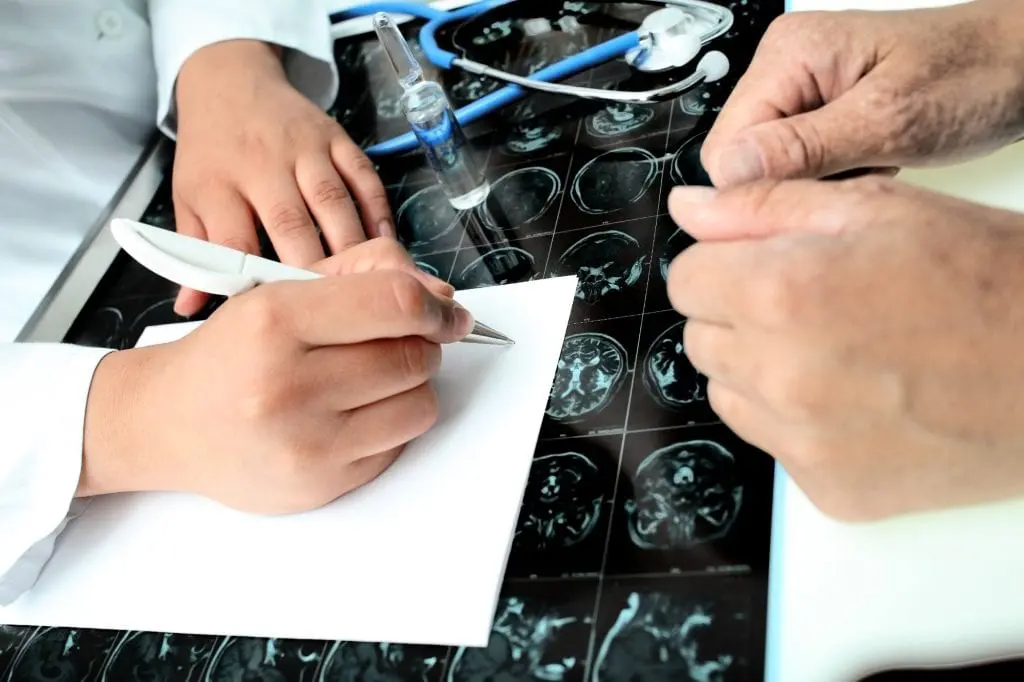If you’re one of the 60,000 Americans diagnosed with Parkinson’s or have a loved one suffering from this disease, then it’s likely you’ll want to know the treatment options available.
Rest assured you’re in the right place because throughout this blog post we’ll be exploring some of the Parkinson’s disease treatment option available.
So without further ado, let’s dive on in!
1. Tricks to Help You Walk
Parkinsons disease can cause ‘freezing’ which in turn makes both walking and balancing harder.
However, appropriate exercise and physical therapy will help the sufferer to cope better with the freezing. With proper Parkinson’s disease treatment, anyone affected by this disease can begin walking without as much pain or difficulty.
Typically, a physical therapist can help patients avoid tripping, stumbling, falling, etc. by helping to teach them to take bigger steps while they’re walking.
We also recommend that if you have Parkinson’s disease, you join an exercise class tailored to those suffering from this affliction. This would be especially useful if you’re taking levodopa.
The exercise will help your body to re-learn and remember your motor skills. This, in turn, will help make walking easier.
2. Advice on Tackling Freezing
There are a few things you can do to help to avoid freezing. For example:
- Marching to a regular beat. A metronome can sometimes help with this, so you might want to consider purchasing one.
- Actively, taking sizeable voluntary marching steps. Try to imagine an imaginary line or chord and attempt to step over it.
- Ensure you effectively communicate with your physician to find which treatment works best for you.
Often, patients with Parkinson’s disease suffer from anxiety and worry about freezing up. When this happens, this can increase the amount of freezing you suffer from.
Hence, a vicious circle starts to occur. So, try and tackle the anxiety, and the freezing will hopefully decrease.
If you think you’re suffering from this, be sure to consult your doctor and perhaps consider taking a course of cognitive behavioral therapy.
3. Participate in Exercise Sessions
As previously discussed, exercise is of paramount importance. In fact, it’s currently the only therapy that drastically reduces the risk of a fall.
As we all know, exercise has a calming effect on the brain. However, it can also help patients regain some of the reflexes needed to maintain balance.
Interestingly, there’s an increasing body of evidence that suggests aerobic and learning-based exercises can help delay the effects of Parkinson’s disease.
You should consider participating in cardiovascular activities as well as sports that promote proper biomechanics, posture, and trunk rotation.
Ideally, you’ll want to try and perform rhythmic and symmetric movements during your workout.
An excellent example of this is dancing in time to music. This is especially useful for tackling stiffness.
Examples of Excellent Cardiovascular Exercises:
You might want to consider the following
- Paced walking (try walking at differing speed and inclines)
- Hiking (with that aid of walking sticks)
- Swimming using differing strokes. You should aim to try and open and close your eyes. This is great for challenging your motor skills!
However, the below exercises don’t challenge your motor skills as much. Therefore, they’re usually not as beneficial in comparison.
- Using a stationary bicycle (without doing any other physical activity)
- Monotonous weight lifting
- Walking on a treadmill at a very slow speed.
- Lap swimming (because this can become habitual)
Examples of Exercises That’ll Help Improve Balance:
If you want to work on maintaining your balance, then you may want to consider participating in any of the following:
- Tai Chi: this is a moving meditation. This exercise aims to shift your body’s center of mass back and forth over your feet.
- Dance (especially the tango): This dance involves walking both backward and sideways. You also have to take significant sized steps, and interchange between following and leading. This is a great way to challenge both your motor skills and your balance.
- Boxing
Whatever exercise you decide to pursue just make sure you go for something you can commit to at least two to three times a week. Plus, you need to pick something that’ll make you sweat.
The Studies Speak for Themselves
A recent study involving 60 participants aged between 50-80 (who have Parkinson’s disease) tested the effects of aerobic walking on this affliction.
The patients took part in 45-minutes worth of moderate intensity walking, three times a week. This went on for a total of six months.
The researchers measured the following factors:
- Aerobic fitness
- Memory
- Mood
- Motor functions
- Cognitive ability
The results of this research suggest that walking regularly at a brisk pace has the following effects (in some patients):
- Improved motor functioning and mood
- Improved attention span and response control
- Reduced tiredness
- Increased aerobic fitness.
So, from this, we can assume that this kind of activity is potentially a useful Parkinson’s disease treatment.
Sadly, this disease doesn’t have a cure at present, so it’s vital that further research is conducted in this field so that one day we have a sufficient Parkinson’s disease treatment.
However, for now, the above advice will certainly help you manage the symptoms of this disease.
Was This Blog Post on Parkinson’s Disease Treatment Useful?
If this information on Parkinson’s disease treatment has resonated with you, please feel free to request an appointment using the form below and come in and see us.
We would love to help you manage this illness as best you can and provide you with the help and information you need to make the most out of daily life.
Just fill out the contact form, and one of our team of professionals will get back to you as soon as they can.
Alternatively, if you’d like more information on how we could assist you, please check out our services page.
.png)



